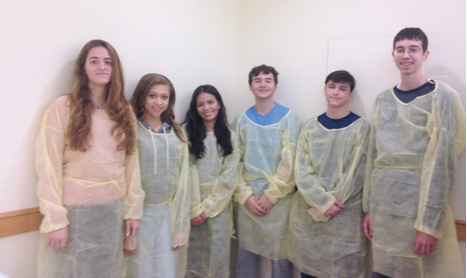By Marianna Tzirani

Mrs. Michal Ashkenazy’s Biotechnology course at St. Francis Prep, Fresh Meadows, is super interesting. We are able to do experiments using the awesome new lab equipment and take trips to learn more about science. One of our recent trips was to the lab at the Lake Success DNA Learning Center in Cold Spring Harbor, L.I.
There, we began extracting our own DNA by obtaining a sample of our cheek cells and tested it for a certain gene associated with certain geographical locations in the world. Through this lab activity, we acquired useful skills and found out more about our cultural heritage.
We tested for the presence of the Alu gene, a small stretch of DNA that “jumps” between certain populations. The gene copies itself and then reinserts itself into new chromosomal locations. After entering our results into the PCR machine, which creates many copies of the DNA to allow us to study it better, we spent an hour touring the Clinical Core Laboratory. We analyzed our DNA using a Chip Analyzer and produced an electropherogram. We saw the genotype each of us has for the Alu insertion.
Then, we entered the Clinical Core Laboratory, which is “home to one of the largest robotic machines involved in diagnostics,” according to the dnalc.org website.
We all wore disposable aprons to avoid contamination and were required to wear closed-toed shoes. We followed our tour guide in single file, staying away from the walls.
The lab itself was a small and very hectic room where it seemed that too many things went on at the same time. It was not like in movies where the lab is a white sterile area where scientists quietly place substances into tubes. The roaring of machinery and stuffiness of the air only added to our excitement!
Most of the hospitals in the area send their test samples to this lab to be studied. Our tour guide explained the complicated process of labeling, color coding tubes and placing them into the correct machines. It seemed so easy to make a mistake as the tubes look almost identical! However, they have a barcode for each patient and barcode readers to avoid confusion.
What is truly special about this lab is that it functions entirely on robotics. All of the processes were done by machines!
We were shown a large assembly line of machines where blood samples are tested. Every process we did by hand in the lab was done quicker and more efficiently by the machines.
In fact, we were told that the lab produces a million test results per month and it has the ability to produce as much as four million results.
I am very thankful for the unique opportunity I had to visit this lab. It was incredibly interesting and I truly confirmed that this is what I want to do in my future.
Tzirani is a senior at St. Francis Prep.
